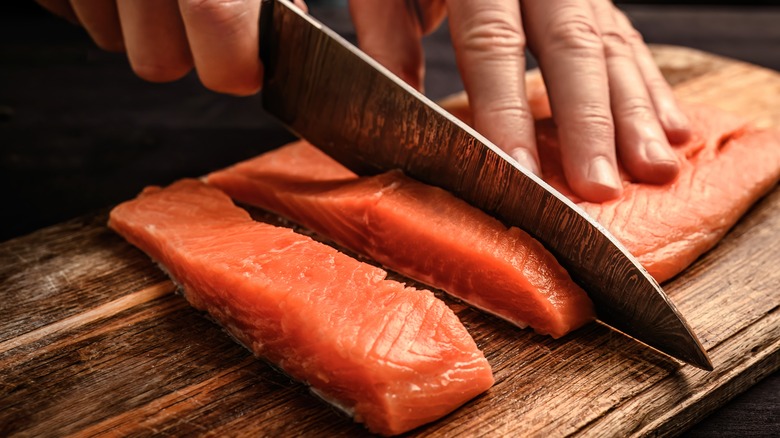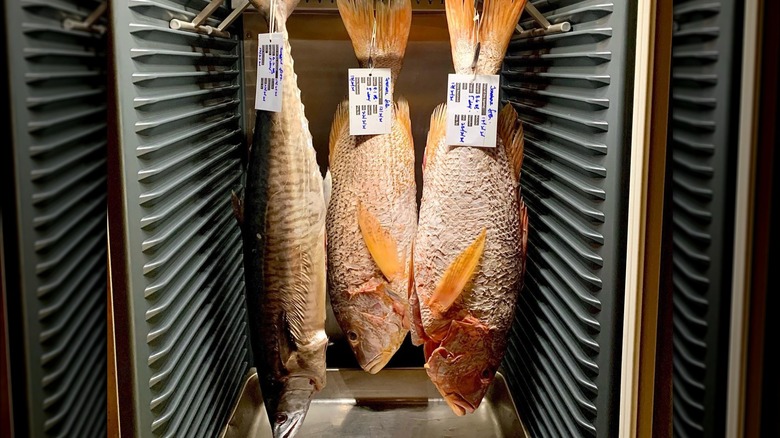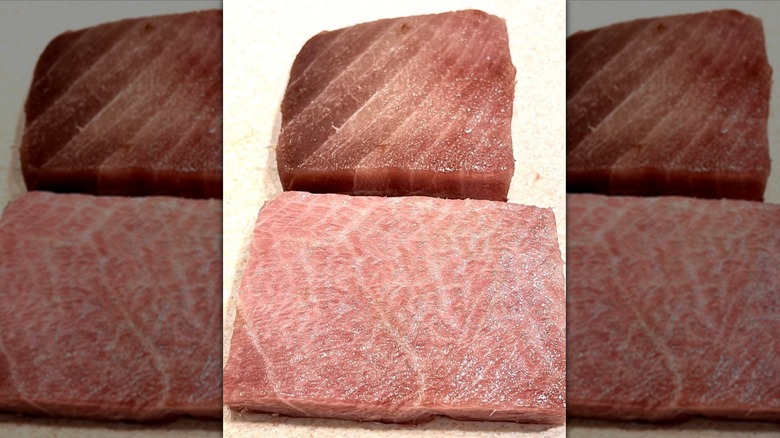The Fanciest Fish Being Served At Restaurants Isn't Actually Fresh
There's a good chance you've heard of dry-aged beef or steak, but have you ever tried dry-aged fish? Similar to how gourmet steakhouses transform standard beef through the long dry-aging process, some chefs swear by dry-aging fish to improve the flavor and texture. Understandably, this might seem backwards considering it's widely thought that fish straight out of the sea is the freshest and therefore the tastiest. But if done right, dry-aged fish is arguably more tender and packed with delicious umami flavor.
Dry aging in general involves hanging or placing a piece of fresh, raw meat in a temperature- and humidity-controlled refrigerator for as long as one month for beef and typically a few days to a couple of weeks for fish, depending on its size. For fish, as it ages in the ventilated, climate-controlled environment, chemical changes occur that improve its texture. For instance, the fish's natural enzymes break down its connective tissues, making it more tender, buttery, and smooth.
In addition to the enzymatic breakdown, the moisture loss that occurs as fish dry ages results in a more concentrated flavor. However, despite the moisture loss and the term "dry aging," the fish is anything but dry in the end. Dry-aged salmon, for instance, is a creamy delicacy, often eaten raw as sashimi or lightly seared.
Background and process of dry aging fish
Despite being a current food trend, dry aging fish has roots in Japan dating back hundreds of years as a form of preservation. Some methods of aging – commonly used by Japanese sushi chefs — involve preserving the fish with ingredients like salt and vinegar. However, today, chefs and fishmongers are increasingly using dry-aging cabinets to ensure the fish doesn't rot by precisely controlling the humidity, temperature, and airflow in the environment. Harmful bacteria can grow in overly humid spaces without proper ventilation so it's crucial to have clean oxygen circulating continuously as the fish ages.
Several types of fish can be dry aged, with some of the most common being salmon, tuna, branzino, and sea bream. The length of aging also depends on the type of fish, with oily, large fish like tuna and salmon needing around three weeks to age for optimal taste and texture, while smaller fish like branzino require only a couple of days. After the fresh fish has been thoroughly cleaned — descaled (the scales can hold moisture so it's crucial to remove them), gutted, and the gills removed — it's typically hung with the head down in an aging cabinet to allow any residual blood to leave the body. Dry-aged fish is touted as a cleaner type of fish since all the guts and blood have been removed, therefore, despite having a more concentrated flavor, it isn't at all fishy-tasting.
Chefs prepare dry-aged fish as a delicacy
Dry-aged fish like salmon and tuna are commonly eaten raw and served at sushi restaurants. The aging makes the fish tender and buttery, perfect for eating as sashimi, but it can also be cooked for a juicy, umami-packed fillet. Speaking with The Peak, Agustin Balbi, executive chef of Hong Kong's Michelin-starred Andō, says, explained that in addition to improving the texture, "The flavor molecules — glutamate and insulate — are released during the ageing process, adding complexity of flavor. Certainly, being a tastier, juicier, and more tender cut, dry-aged fish is also easier to cook."
It's nearly impossible to discuss dry-aged fish without referring to Liwei Liao, also known as the "Dry Aged Fish Guy". As owner the Joint fish market in Sherman Oaks, California, Liwei says "fresh is boring," when it comes to fish, evidenced by his dry-aging refrigerators that are large enough to hold 4,800 pounds of fish at a single time. According to his Instagram, the fishmonger has been in the fish business for 30 years and aged his first tuna when he was only 11 years old. Liao now supplies dry-aged fish and provides guidance to multiple chefs at L.A. restaurants.
Some people say you can dry age fish at home by wrapping it in paper towel and putting it in an air-tight bag in the refrigerator. But others say leave it to the professionals since a normal refrigerator doesn't have the same controlled environment as an ager. But if you're looking for ways you can easily prepare salmon, then curious minds should check out the only salmon guide you'll ever need.


